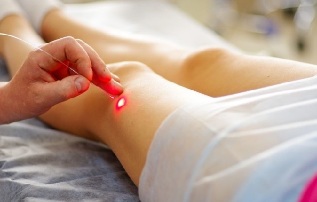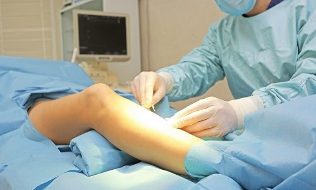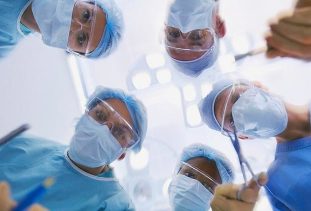In such situations, the doctor does not offer another option but to remove the affected area superficial veins. And the sooner the better, because the delay is fraught with serious complications.

Dangerous surgery to remove varicose veins on the legs, what are the different methods of combating the disease, and how much is one or the other procedure to remove the veins varicose veins – all relevant information in our material.
WHAT IS THE CAUSE OF THE PROBLEM?
Generally affects varicose subcutaneous veins of the lower extremities. The blood is governed by the same laws of physics as any liquid on the planet, under the force of gravity to aim it down.
But the peculiarity of the cardiovascular system lies in the fact that the blood is constantly circulated and had all the vital organs.
To stagnate in the superficial veins of the legs and other extremities she does not allow the work of the special valves.
It is the latest failure causes discharge of the blood into a thin saphenous vein, the walls of which gradually lose their tone, become thin and stretched.
Unfortunately, to return strongly dilated superficial veins previous form is not possible even with the restoration of function of the valves.
Their insufficiency can be the root cause of varicose veins, and the result of certain conditions of the body.
Risk factors:
- pregnancy, more precisely, the associated increase in the volume of blood in the body of the expectant mother, as well as the increased pressure on the veins from the uterus with the fetus;
- a long standing – this applies to those whose occupation involves regular long stay in static position (surgeons, teachers, hairdressers and the like);
- "sedentary" work – virtually the same as a permanent condition. Muscle tone and veins decreases, the blood stagnates in the legs, the valves cease to function normally;
- the increased load on the legs – affects the veins in the same way as the previous two factors;
- obesity – excess weight greatly increases the load on the heart, blood vessels and veins. In addition, a large layer of subcutaneous fat is often more difficult to diagnose varicose;
- age – related changes over time venous walls and valves weaken, lose their tone and stretch;
- Accompanied by constipation, prostate adenoma, chronic cough, and becomes the cause of hemorrhoids and varicocele;
- the effects of trauma, the reviews confirm what is common, and operations on the lower extremities;
- thrombosis of deep veins are not superficial, as mistakenly believed by many patients, namely the deep – the pressure rises, and blood rushes into the saphenous vein;
- hereditary diseases, for example arterial-venous fistula, or fistula;
- aesthetic treatments – vacuum wrap, aggressive massage;
- excessive physical activity.
INVASIVE TYPES OF SURGERY VEINS ON THE LEGS
When ointments, pills and special compression underwear is powerless, the only way out is the exception to the venous system of the legs of her varicose veins affected areas.
The choice of operative intervention depends on the type and stage of the disease, there are changes, skin condition and comorbidities.
Phlebectomy (TOP 5 techniques)
This is a classic method that involves the removal of extended areas of the veins through incisions in the skin. Phlebectomy has been practiced since the early 20th century, the technique of its carrying out is brought almost to perfection.
The entire procedure lasts from 1 to 2 hours and does not require a long stay in hospital (most within the same day).
In most cases, the doctor performs a combined procedure, i.e. using several different techniques:

- Stripping – removing the vein after ligation and fixation of a special tool. Partial Stripping involves a partial removal, and total. This type of surgery to remove veins on the legs is considered special, because all manipulations are done through a small puncture in the skin so that no stitches needed.
- Micro-phlebectomy is different from the traditional one that runs through the punctures, that is, without cutting the tissues.
- Endoscopic procedure – widened section is removed after insertion into a vein of the endoscope, that minimizes potential complications after surgery.
Sclerotherapy
In the lumen of the enlarged plot introduces a special ingredient – which just glues the inner wall of the vein, over time it becomes a scar tissue. Sclerotherapy is used to treat not only varicose veins but also of varicocele.
Laser photocoagulation
Surgery on veins in legs laser is performed without incision of soft tissues. Veins do not need to get – it just "sealed" with a special laser fiber is inserted through a small puncture.
Many positive comments about the surgery on the leg veins laser indicate a minimum probability of negative consequences, relapse of varicose veins, however, it depends on its stages and causes.
In addition, the patient after a couple of hours after the procedure she can go home, as the stitches do not need.
Doctors say that when exposed to laser light from an excluded entry into the body of the infection.
Lasers are used in the treatment of small veins from the medical point of view, such as telangiectasia is small veins up to 1 mm in diameter.
Often requires several stages of treatment. This method is less effective in the treatment of large varicose veins in the later stages.
INDICATIONS AND PREVENTIVE MEASURES
Doctor compulsorily appoint a particular type of operation on the veins in the following situations:
- varicose veins in a state of neglect, apart from the aesthetic problems of a person greatly concerned about the pain;
- the movement of blood through the veins is impeded, the patient feels a permanent pain and heaviness in the legs, their excessive fatigue;
- the pathologically enlarged vein;
- the skin is a lesion of the trophic character (e.g., non-healing ulcers);
- pointed handicap thrombophlebitis;
- severe swelling of the limbs;
- the violation of the outflow of blood, which occurs even in the absence of dilated superficial veins.
If there is a predisposition to varicose veins or the patient is at risk, it is necessary to prevent:
- wear the compression garment;
- use of drugs;
- daily use of vitamin C, which in sufficient quantities has a positive effect on the vascular wall and rheological characteristics of blood.
CONTRAINDICATIONS
Unfortunately, even with the variety of modern methods of treatment of varicose veins, procedures to remove dilated vein portions have a number of contraindications:
- hypertension;
- coronary artery disease;
- a severe form of infectious diseases;
- the presence of skin eczema, erysipelas inflammation or dermatitis;
- pregnancy from 5 to 9 a month.
HOW TO PREPARE FOR SURGERY

Doctor before prescribe surgery, should send the patient to the passage of the diagnosis, and then make the decision in accordance with the results of the check:
- Doppler ultrasound of veins and vessels;
- duplex ultrasonography is a more detailed test, is also shown to exclude the presence of thrombi in the deep veins;
- a magnetic resonance procedure – this test can give information about the presence of blood clots in the deep veins;
- the analysis of blood laboratory tests did not help in the diagnosis of varicose veins, but are necessary if you need to do the operation.
Directly before the procedure, the patient should:
- take a shower;
- to remove the hair with the operated leg (if necessary also in the groin area);
- come a little before the appointed time.
In the case of the behavior of a traditional surgery that involves General anesthesia, the patient is put enema.
It is essential that the anesthesiologist was alerted to the presence of a person allergic to any medicines.
Varicose veins need surgery. With the method of surgical treatment will help a vascular surgeon. There is a danger in case of refusal of operation? Of course! A fatal complication of varicose veins – thrombosis of vessels of the vital organs of the body, ischemic stroke, thrombosis. The risk of complications increases with age.
All invasive treatments of varicose veins will help get rid of enlarged saphenous veins and associated pain. But you need to understand that the duration of the effect after eliminating the aesthetic deficiency depends on many factors, among which a special role is played by heredity and lifestyle.
It is necessary to maintain the muscles of the blood vessels in good shape to the limbs does not stagnate the blood, but also try to keep a normal weight, wear comfortable shoes and to give up bad habits.




































